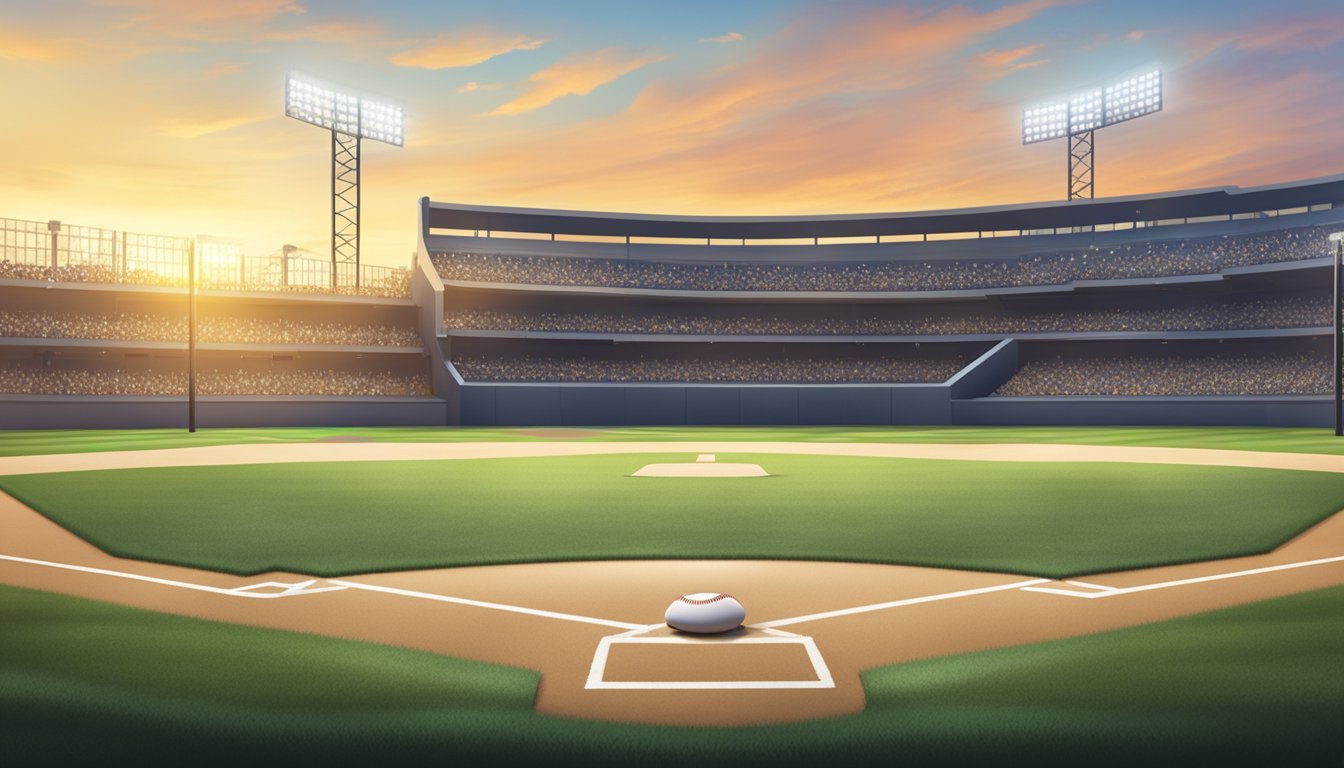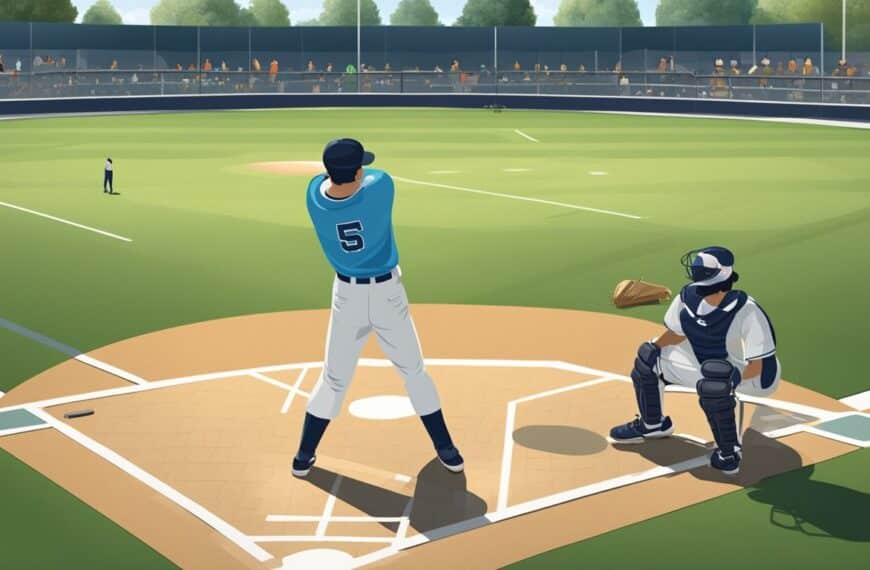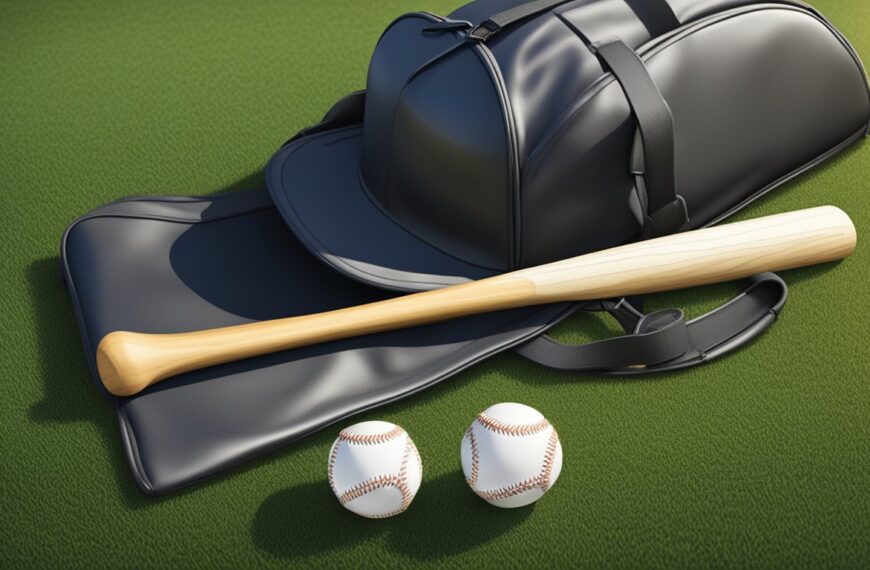In baseball and softball, the use of a batting tee is a fundamental part of learning and refining a player’s swing. The quality and durability of a tee can significantly affect a player’s practice routine. While traditional tees were simple and made from a limited range of materials, today’s market offers a broad spectrum, each with its pros and cons.
Materials can range from rubber to high-grade polyurethane, with varying rigidity and impact absorption. Rubber tees are often praised for their flexibility and affordability, whereas newer composite materials may offer superior durability and weather resistance. Selecting the right material for a batting tee is critical, as it must withstand repeated use and provide consistent support for the bat.
Key Takeaways
- Batting tees made from different materials directly influence a player’s practice effectiveness.
- Material choice impacts the durability and weather resistance of batting tees.
- The right batting tee material can enhance training by providing consistent swing support.
Understanding the Importance of Batting Tees
https://www.youtube.com/watch?v=ELo4zAOKTkg&embed=true
Batting tees play a crucial role in the development of a baseball player’s hitting abilities. They provide a consistent, stationary target that allows players to perfect their swing mechanics through repetition.
Role in Hitters’ Development
In its role for hitters’ development, a batting tee is an essential training tool. It allows hitters to focus on hitting the ball at different heights and angles without the variability of a pitched ball. Practice with a batting tee can help a hitter develop muscle memory for their swing, creating consistency in their hitting mechanics. Hitters can isolate and work on specific parts of their swing, refine their hand-eye coordination, and adjust their timing.
A batting tee supports gradually increasing the complexity of hitting drills. As a hitter becomes more adept, the tee can be used for various drills targeting different zones of the strike zone:
- Inside pitches: Hitters learn to keep their hands close to their body.
- Outside pitches: They work on extending their arms to reach effectively.
- High and low pitches: They train to adjust their swing path.
Components of an Effective Swing
An effective swing encompasses several key components:
- Stance: A consistent, balanced stance is the foundation of a good swing.
- Grip: The way a hitter holds the bat can dramatically affect their swing’s power and control.
- Load: Proper loading of the hitter’s weight ensures potential energy is built up before the swing.
- Stride: An efficient stride toward the ball helps maintain balance and timing.
- Swing path: A deliberate path of the bat influences contact quality and dictates the ball’s trajectory.
- Follow-through: A complete follow-through contributes to the power and direction of the hit.
Through the use of batting tees, hitters can methodically practice these components. Isolating each element allows the player to make incremental improvements to their swing mechanics. Over time, the repetition forms the muscle memory needed to execute a powerful and precise swing during live game situations, transforming practice into performance.
Material Types and Their Properties
Choosing the right material for a batting tee can greatly influence a player’s hitting experience. Material choices affect not only the feel and durability of the tee but also its stability and the versatility it offers during practice.
Classic Tees: Durability and Feel
Classic tees are traditionally made from durable, high-density plastics or metals, offering a sturdier base for repetitive use. Materials like flexible rubber top the tee for a softer contact, which can affect the feel of the swing. These tees stand out for their:
- Longevity: Resistant to cracking and fading.
- Tactile Feedback: Provides a more realistic sensation mimicking in-game hitting.
Hybrid Tees: Versatility and Stability
Hybrid tees merge materials such as rubber and metal to balance flexibility and stability. The base often includes weight distribution features for increased stability, reducing the likelihood of tipping during an aggressive swing. Characteristics include:
- Adaptability: Suitable for various skill levels and environments.
- Consistent Experience: Minimizes variables that affect the path of the bat.
Concept Tees: Innovation and Mechanics
Concept tees incorporate technological advancements and innovative designs to enhance the mechanics of batting. These tees may use advanced polymers for an optimal mix of weight and resilience. They often focus on:
- Mechanical Realism: Introduces elements like adjustable heights and angles.
- Skill Development: Aims at improving specific aspects of the player’s swing.
Comparing Popular Batting Tee Brands
In the batting tee market, brands like Tanner Tee and G Tee stand out for their quality and customer service, while other brands offer diverse options, each with unique features and warranties that cater to various customer needs.
Evaluating the Tanner Tee
Tanner Tees is renowned for its durability and customer service. Their classic model features a hand-rolled rubber top that is both sturdy and gentle on both bats and hands. They offer a standard one-year warranty, signifying confidence in their product’s longevity. Customers often note the brand’s responsiveness to inquiries, enhancing the overall user experience.
The G Tee Advantage
G Tee takes pride in its precision and adjustability. The tees boast a patented telescopic design, allowing for quick height changes. They’re constructed with a combination of heavy-duty stainless steel and composite materials, providing a stable hitting platform. Their emphasis on a long-lasting product is backed by a two-year warranty on all parts, showcasing the company’s commitment to quality.
Assessing Other Market Competitors
Other competitors in the market vary widely in materials and design, aiming to satisfy the diverse needs of different players. Some alternatives:
- Adjustable Heights: Ranging from youth to professional levels
- Material Variety: Includes industrial-grade rubber, heavy-weight plastics, and metal alloys
- Warranty Options: Can extend from a few months to multiple years, reflecting the confidence brands have in their durability
- Customer Service: Varies significantly; however, most reputable brands maintain satisfactory support services
Each brand in the broader market is striving to balance cost, functionality, and customer satisfaction to carve out their niche.
Design and Usability
When choosing a batting tee, design elements such as adjustability and portability are as crucial as the material it’s made from. These factors directly influence the usability of the tee in different practice settings.
Adjustability and Placement
An adjustable stem is essential for a batting tee as it allows for height changes to accommodate different strike zones. A well-designed tee should offer:
- Ease of adjustment: Quick and simple mechanism to change heights.
- Range of heights: A span that covers the user’s knees to chest.
Proper placement near home plate is facilitated by an adjustable stem, which should be sturdy enough to withstand repeated contact without losing its position.
Portability for Practice On-the-Go
Portability factors in the willingness to transport the batting tee. Key features include:
- Lightweight design: Easy to carry without strain.
- Compact form: Ability for the tee to be broken down or folded.
A portable baseball tee should be designed to effortlessly fit into a vehicle or equipment bag for practice sessions away from home.
Stability and Contact
The base of a batting tee impacts its overall stability. It should:
- Prevent tipping: Broad and weighted enough to stand upright after contact.
- Absorb impact: Durable to withstand the force of swung bats.
Each hit’s contact with the tee gives feedback on the swing’s accuracy and the sustainability of the tee’s design.
Training Benefits and Drills
In the realm of baseball and softball, the use of batting tees is integral for optimizing performance at the plate. They allow batters to focus on specific areas of their game, from the fundamentals of swing mechanics to the intricate development of hand-eye coordination.
Reinforcing Proper Hitting Mechanics
Practicing with a batting tee helps players establish and reinforce proper swing mechanics through repetition. They can isolate and work on phases of their swing in a controlled environment, with an emphasis on maintaining a consistent stance, grip, and swing path. The tee allows players to repeatedly hit the ball at various contact points, ensuring that they can make adjustments to their swing and work towards finding the sweet spot on their bat.
- Key points for mechanics:
- Stance
- Grip
- Swing path
- Contact point
Developing Hand-Eye Coordination
Hand-eye coordination is critical for hitting a baseball accurately, and batting tees provide an excellent foundation for this skill. Unlike live pitching or coach pitch, the stationary ball on a tee eliminates variables, permitting the batter to solely focus on their visual acuity and precision. The repetitive nature of hitting off a tee builds muscle memory, which translates to improved timing and better contact during live gameplay.
- Exercises to enhance coordination:
- Focused target practice
- Varying tee heights and positions
- Soft toss drills
Practicing Pitch-Specific Skills
An advanced technique in tee work is to simulate different pitch locations and types. Batters can position the tee to mirror the trajectory of high, low, inside, or outside pitches. This practice encourages batters to adjust their swing to cover the entire strike zone effectively. It contributes to a hitter’s ability to adjust to pitch-specific scenarios they’ll face during games, fostering a level of preparedness for any pitch thrown their way.
- Drills for pitch-specific training:
- High tee for upper zone pitches
- Low tee for pitches at the knees
- Inside and outside positions for edge strikes
Practical Considerations for Coaches and Players
Coaches and players need to make informed decisions about batting tees to maximize skill development and address the distinct needs at various levels of play.
Selecting the Right Tee for Major League and High School Baseball Players
Age and Skill Level:
- Tee-Ball to Youth:
- Material: Plastic; resilient, lightweight
- Height Adjustability: Easy to alter; accommodates growth spurts
- High School to Major League:
- Material: Metal or industrial-grade rubber; durability for repeated use
- Skill Considerations: Adjustable height and stem flexibility for varied pitch locations
Combating Common Hitting Flaws
Bad Habits: Coaches frequently utilize batting tees to correct player stances and hitting flaws.
- Dropping the Shoulder:
- Exercise: Place the tee higher to encourage the player to keep the shoulder up and hit line drives.
- Inside Pitch Struggle:
- Exercise: Position the tee closer to the hitter to work on keeping the hands inside the ball.
- Hitting to the Opposite Field:
- Exercise: Tee is set up away from the hitter to practice hitting outside pitches to the opposite field.
Maximizing the Training Environment
Training Environment:
- Space: Ensure the tee’s base allows for ample room positioning to mimic real plate scenarios.
- Durability: Opt for tees with a stable, sturdy base to withstand the rigor of extensive practice.
Player Development:
- Focus on Fundamentals: The tee should cater to the development of a direct path to the ball for a solid line drive approach.
- Repetition: Durable materials like heavy-duty rubber or metal ensure players can repeat drills without interruption.
Investment and Longevity
When considering the purchase of a batting tee, one must weigh the cost against anticipated performance and durability. Warranties and manufacturer support can also have a significant impact on the value of the investment.
Evaluating Price versus Performance
Durability vs. Cost: Batting tees crafted from high-quality materials such as rubber or industrial-grade polymers offer a longer lifespan, reducing the need for frequent replacements. Although the initial investment may be higher, the tee’s longevity often justifies the expenditure. For instance, the Tanner Tee is known for its durable design, which balances the cost with a steadfast performance.
| Material Type | Estimated Lifespan | Initial Cost |
|---|---|---|
| Rubber | Long | $$ |
| Polymer | Very Long | $$$ |
| Metal | Long | $$ – $$$ |
| Plastic | Shorter | $ |
Warranty and Manufacturer Support
Warranty: A comprehensive warranty protects the buyer’s investment, signaling the manufacturer’s confidence in their product. The existence of a Tanner guarantee or similar warranty offers peace of mind and potential cost savings should the product fail prematurely.
| Brand | Warranty Length | Covered Issues |
|---|---|---|
| Tanner Tee | Various Terms | Material, Workmanship |
| Brand X | 1 Year | Defects Only |
| Brand Y | 90 Days | Limited Issues |
Customer Service: Manufacturer support is a cornerstone of the purchasing decision. A company with a strong commitment to customer service can greatly enhance the product experience through helpful assembly instructions, prompt response to issues, and support in the event of a warranty claim. This level of service contributes to the overall worth of the investment in a batting tee.
Advancements and Trends in Batting Tee Design
Recent batting tee design advancements focus on improving training efficiency and durability. Innovations cater to both baseball and softball, with market trends reflecting an emphasis on technology and versatility.
Technological Enhancements
Materials: Batting tees are now featuring cutting-edge materials such as advanced polymers and composites. These materials offer superior durability and resistance to the wear and tear of repetitive use, unlike traditional rubber or metal tees. For instance, a flextop design incorporates a flexible rubber top that better absorbs the impact of the bat, reducing the likelihood of breakage.
Sensors and Feedback Systems: Certain tees are equipped with electronic sensors that provide immediate feedback on the quality of the player’s swing. This technology can be synced with software applications, allowing coaches and players to analyze swing data and make adjustments in real-time.
Adaptability to Modern Training Techniques
Adjustability: The latest batting tees display a marked adaptability, with adjustable heights and bases that can be easily repositioned. This allows them to cater to a range of ages and experience levels, from T-ball to professional players, ensuring that athletes of all sizes can practice their swing mechanics effectively.
Training Integration: Modern tees work with a multitude of training aids and can be seamlessly integrated into various drills. They support the evolving techniques of contemporary training regimens, which often incorporate additional softball and baseball equipment to enhance agility, power, and precision.
Conclusion
When selecting the best batting tee for practice, one must assess the materials based on their distinct advantages and potential drawbacks.
Durability is critical for frequent swing practice, and the sturdiness of rubber or metal tees may suit the busy environment of a batting cage or garage setup well. However, for those in the big leagues, investing in high-end composite materials can offer both resilience and a professional feel.
| Material | Pros | Cons |
|---|---|---|
| Rubber | Durable; Affordable | Heavy; Less Portable |
| Metal | Very Sturdy; Long-lasting | Prone to Rust; Heavier |
| Composite | Lightweight; Top Quality | More Expensive |
Choosing a flexible and easily adjustable tee could significantly benefit players’ development, allowing for a wide range of swing heights and styles. This flexibility can translate to better performance during games.
While the material choice will vary based on individual needs and environments, the consistency of practice—regardless of tee material—remains the foundational element to improve batting skills. Players should therefore prioritize quality and suitability for their specific practice routine, whether it occurs in a cage or personal garage.
Frequently Asked Questions
In this section, we address some common inquiries regarding the various materials used for batting tees and how they relate to performance, durability, and training effectiveness.
What are the benefits of using a rubber vs. metal batting tee?
Rubber batting tees are valued for their flexibility and resistance to harsh weather conditions, while metal tees are preferred for their sturdiness and long-term durability.
How does the material of the batting tee affect its durability?
Batting tees made from high-density polyethylene or rubber tend to withstand repeated use and resist cracking. Metal tees, though susceptible to corrosion, often last longer if maintained properly.
Can the type of batting tee material impact a player’s training routine?
Certainly. A heavier tee, like one made of metal, might stay more stationary during practice, while a lighter rubber or plastic tee could introduce variability that helps a player adjust to different hitting conditions.
What are the advantages of portable batting tees for practice sessions?
Portable batting tees, typically made from lightweight materials, enable players to easily transport and set up practice sessions anywhere, providing valuable flexibility in their training routine.
How do different materials used in batting tees influence price and quality?
Generally, metal batting tees are more expensive due to their longevity and stability, whereas plastic and rubber tees are more affordable but might require more frequent replacement.
In what ways do batting tee materials affect the feel of the bat’s impact?
Materials like rubber can absorb some of the impact, providing a softer feel, while metal and hard plastics transmit more of the contact to the bat, offering a more realistic simulation of in-game batting conditions.

















